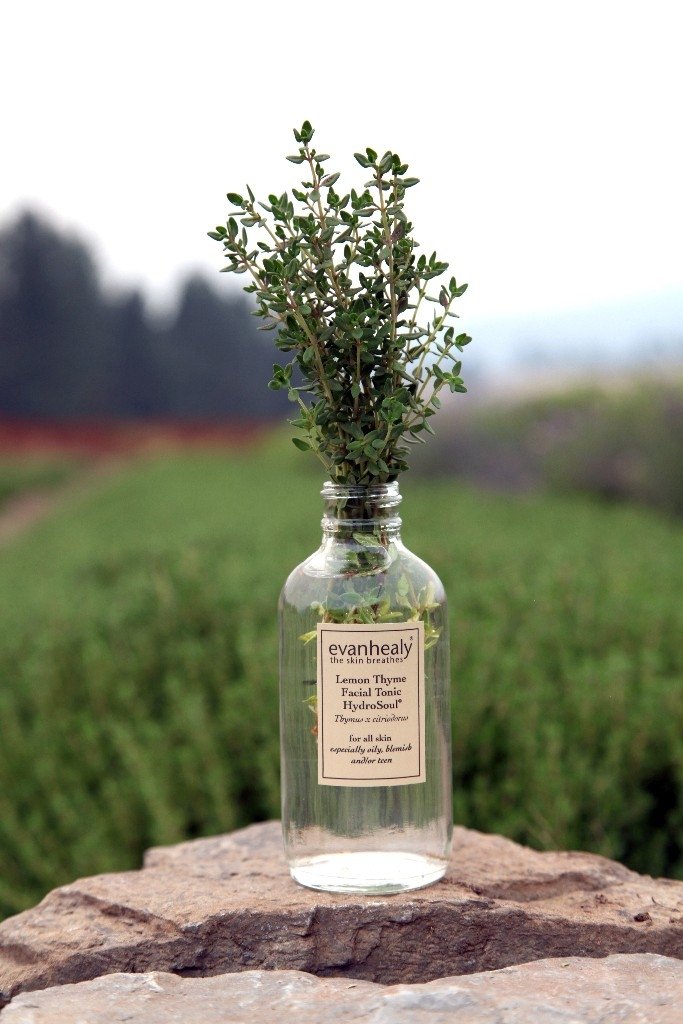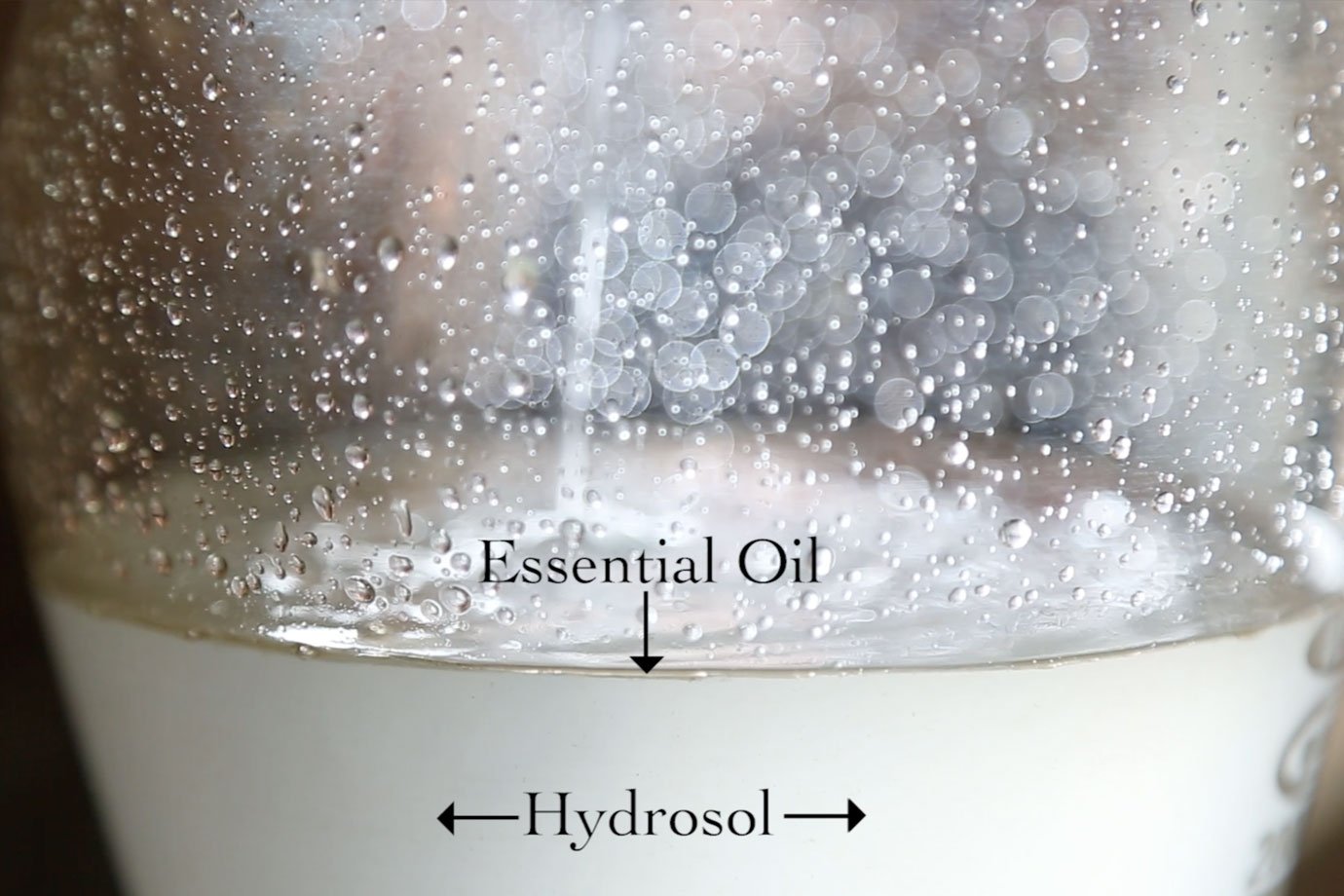What is a hydrosol?

Hydrosols are pure plant waters extracted through the ancient art of distillation.
Simple, gentle, powerful — these waters have been used for millennia to bring harmony and serenity to skin and spirit.
Through Evan’s decades of experience with the skin, we have found hydrosols to be the single most transformative element someone can incorporate into their skin care ritual.
Because of their remarkable effects, we weave them into every aspect of our skin care line.
We combine them with our oil serums to create our foundational moisturizing technique. We weave them into the formulations of our cleansers and moisturizers. We mix them into our clay masks.
They are the single thread that runs through everything that we create.
Hydrosols and Essential Oils
Hydrosols and essential oils are co-products of the distillation of aromatic plants.
Essential Oils are the volatile, fat-soluble compounds from within the plant. They are powerful, active, and extremely concentrated. It takes two thousand pounds of lavender to make one liter of lavender essential oil. Because of their tiny molecular size, essential oils absorb swiftly into the body. Without properdilution they can tax the liver and other organ systems.
Hydrosols are primarily the water-soluble elements of the plant, though they also contain micro-amounts of essential oil, as well as cellular water - which is the water from within the plant itself.
Containing this dynamic variety of constituents, hydrosols are an imprint of the whole plant. It takes eight pounds of plant material to make a gallon of hydrosol. They are gentle, yet effective, and completely safe. There is no need to dilute.
Both essential oils and hydrosols have an important place in holistic skin care.


Hydrosols are gentle remedies that offer an immense array of benefits to all skin. They are one of our best allies in the world of skin care.
What Our Hydrosols Contain
- Water-soluble compounds from the plant
- Cellular water from within the plant
- Micro amounts of essential oils
What Our Hydrosols Do
- Tone
- Hydrate
- Plump
- Balance pH
- Work in synergy with oil serum - anchors in moisture
- Deliver therapeutic compounds from the plant into the skin
Hydrosols are the missinglink in hydration.
Proper hydrating and moisturizing is the union of oils + waters. Many people who use a face oil alone are often unsatisfied with the results, or feel they also need a moisturizer. This is because using an oil alone is only half of the moisture/hydration equation. Integrating a hydrosol into your daily protocol -- especially when used with a face oil, balm, butter or moisturizer -- completely transforms the efficacy of your skin care, and elevates it to the next level.
Like homeopathy, hydrosols do not address symptoms that are not there. They will not throw the system out of alignment. For example, although Lemon Thyme is a great choice for oily skin, it does not dry the skin out, and thus is a wonderful tonic for dry skin as well.
Unless you have an allergy or a scent-aversion, there is no wrong choice when selecting a hydrosol.
The Distillation Process
We distill for the hydrosol alone, which is a very different process than distilling for essential oil.
Harvest.Plants are harvested during their peak, and at the time of day where the temperature draws the most aroma-molecules into the leaves and flowers of the plant. Harvest temperatures vary from plant to plant. This step ensures that the most therapeutic compounds are delivered into the hydrosol.

Into the Stills.The fresh plant material is then put immediately into hand-hammered copper stills that have been partially filled with well water. Using fresh plant material is especially important when distilling for hydrosol, because you are trying to capture the plant’s cellular water and if you leave the plant material to wilt that cellular water evaporates.

Depending on the plant, the harvest is either put directly into the water within the pot - which is considered a hydro-distillation - or put into the column, which is considered a steam distillation. Occasionally, certain plants benefit from a combo-distillation which utilizes both hydro and steam distillation, simultaneously.
A flame is lit under the stills and the water is brought to a gentle simmer. As the steam rises, it breaks open the glands in the plant that contain the aromatic molecules. Carried by the steam, the aromatic molecules rise to the top of the hat, travel through the swan neck, and then spiral down through the condenser coil. The condenser coil is immersed in cool water, and as the traveling aroma-molecules reach this stage, the temperature change shocks them from vapor into solid, or as we like to think of it, from spirit to matter.




The final product is both essential oil, and hydrosol.

Spectrum of Quality
In aromatherapy, the term ‘hydrosol’ applies only to the therapeutic water created from the distillation of aromatic plants. In the world of skin care, there is a lot of misuse of the word ‘hydrosol’ and it is often used to describe products that are not truly distilled plant waters. A hydrosol is not essential oil added to water or any other combination of ingredients. A hydrosol is only one ingredient — pure plant water.
Even with authentic hydrosols, there is not a lot of transparency around how they are crafted and it’s often assumed that all hydrosols are created equal. This is far from the case. The spectrum of hydrosol quality is vast, and a little messy. We’ve compiled some quick guidelines to help you understand what to avoid, and what to seek out.
What to Avoid with Hydrosols
BYPRODUCT HYDROSOLS. These are authentic hydrosols, but a mass-produced byproduct from the essential oil industry. They lack potency and vitality and many of the key constituents that occur in a properly distilled hydrosol.
RECONSTITUTED HYDROSOLS. Shipping large amounts of hydrosols — especially from Europe — is incredibly expensive, and to cut corners, some producers will dehydrate/concentrate their hydrosol. When the US entity receives this dehydrated hydrosol (an oxymoron), the company then reconstitutes it with water
DISTILLED FROM DRY PLANT MATERIAL.This is more common than you might think. When you distill from dry plant material you only get a fraction of the therapeutic compounds and benefits that a hydrosol should contain.
WATER AND ESSENTIAL OIL.Some products claiming to be hydrosols or plant waters are actually just water with essential oil added to it; or water and a fragrance oil with a dispersant added. Since oil and water don’t bind without some sort of emulsifier, a dispersant is often utilized. As an ingredient, the dispersant often goes unlisted.
What to Look for In A Hydrosol
- Distilled from fresh organic plant material, harvested at peak hours
- Created in small batches
- Distilled specifically for the hydrosol — not a byproduct of essential oil distillation
- Distilled in copper or glass — not stainless steel
Hydrosol vs. HydroSoul
While hydrosol is the default term to describe the plant water created through distillation, we choose to use the name HydroSoul because we feel it captures the true nature of what a hydrosol really is. The soul of the plant.
Since hydrosol can refer to a plant water that is likely a byproduct, reconstituted, and/or distilled from dried plant material, we wanted a word that represented the truth, beauty, and potency of our artisan distilled hydrosols, and that would communicate that they are something real, transformative and profound. HydroSoul.
In this piece, for educational purposes, we take the liberty of using them interchangeably, but we consider each one of our hydrosols to be a HydroSoul.
A Brief History of Aromatic Plant Distillation
Aromatic plant distillation is truly an ancient art. The oldest discovered stills were found on the island of Cyprus — called the island of Aphrodite, which seems appropriate — and are dated to be around 4000 years old. Made out of clay, the remnants of their contents included lavender, bay, rosemary, pine, coriander, anise, bergamot, almond, and parsley to name a few.
These were the days before the invention of the condenser coil, which means the distillates they were creating were synergistic perfume waters — or hydrosols.
Botanical fragrance at this time was used as medicine and perfume, for cosmetics, and for ritual and worship. And likely for something more — something lost to us in the modern world. This was a time in history when fragrance had a weight and place. It was not seen as a frivolous, or vain, but something vital and profound. It was an incredibly important aspect of both culture and religion.
For a few more millennia distillation went on in much the same way — hydrosols being the sole product.
During the 11th century, the condenser coil was invented. The condenser coil, being bathed in cool water, was able to concentrate and extend the distillation. This led to the discovery of essential oils. There is some mystery surrounding who exactly invented this integral component, though many believe it was the Iranian physician, alchemist, and mystic Avicenna.
Even after the discovery of essential oils, it still took several hundred years for essential oils to become popularized and take root as the dominant distillate. In the 17th century, you could purchase essential oils as medicines in European apothecaries. Hydrosols dwelled on the sidelines but were still used and renowned as effective “beauty waters” to enhance the complexion.
Shoot forward to present day, and here we are, part of a small community working to bring about a hydrosol resurgence, and to share the ancient wisdom, magic, and power of these remarkable plant waters with the world.
How to Use A Hydrosol

Hydrosols are team players and can be used in every step of your skin care ritual. They enhance and amplify the benefits of anything you use them with - cleanser, oil serum, moisturizer, mask.
The best, simplest, and most effective way to incorporate hydrosols into your daily life is by pairing them with an oil serum. This re-creates the protective barrier the skin creates for itself and acts as an antioxidant treatment,toner and moisturizer in one. Ideally, this combination is used morning and night.

Other Ways to Apply A Hydrosol
- Saturate the face, morning, night and throughout the day — even over makeup.
- Apply after cleaning and before your moisture step (oil serum or moisturizer).
- Use as the liquid element of Clay Masks, or Lemongrass Facial Polish.
- Use as a gentle morning cleanser by simply saturating face with hydrosol, then softly patting the skin with a clean cloth.
The more hydrosol you use, the calmer, softer, and more luminous the skin becomes.
Hydrosol Perfection is a Journey
We source all of our core hydrosols from a group of eleven family farms and distillers in northeastern Washington state. While we are dedicated to transitioning all of our hydrosols to our copper-distilled, hydrosol-focused distillation approach, we also work with a handful of family distillers in the essential oil industry who bring exceptional quality and expertise to what they do.
Rose Petal HydroSoul is from a family-run distillery in Bulgaria, certified organic, and the sweetest and most enchanting Rosa damascena we’ve found.
Frankincense HydroSoul is harvested in Somaliland, distilled in Vermont in an incredibly long and slow distillation that creates a both a powerful plant water and a powerful essential oil — we use this oil in our Argan Intensive Serum+ Sweet Blossom Body Oil.
Immortelle HydroSoul is distilled in its native land of France by a family-run distillery.


